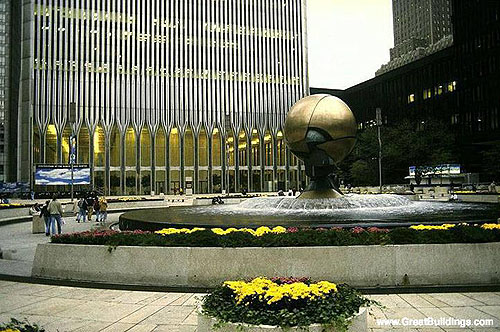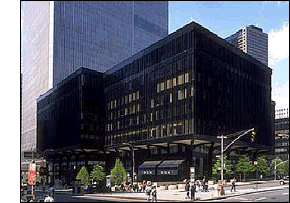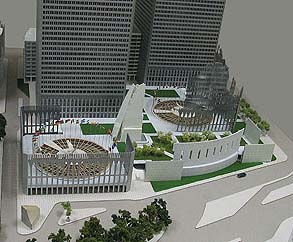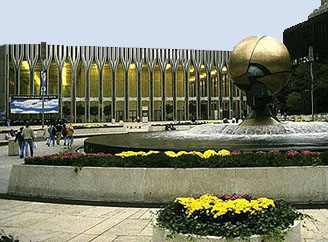- Q: How should names be listed at the memorials?
- A: Standard practice for national memorials is to have the arrangement and placement of names approved by a committee made up exclusively of surviving family members. The LMDC has not done this. A good solution is to list those that died in each tower at the respective footprint memorial, and to have additional separate memorials at the southwest site corner for other victims, including rescue workers and responders, with memorial designs approved by the respective family members.
- Q: Why did the Pataki administration insist the old street grid prior to the WTC be restored? Isn't this detrimental to security?
- A: To provide real security for the Freedom Tower, surface vehicular traffic should be eliminated from the WTC site. The new streets are excellent truck-bomb routes through the site. That is why streets around the New York Stock Exchange and downtown police headquarters have been closed. It is interesting that the police do not allow traffic near their building, a relatively low priority terrorist target, but WTC planners require traffic be allowed through the WTC site although it is designated a high priority target. Why is the Freedom Tower a windowless concrete bunker, and not other buildings on the site? Confusion reigns. Another major issue is the old street grid is not suitable for big buildings, which is why it was removed in the first place. But without the old street grid the amateurish and discordant LMDC site plan can not be justified.
- Q: How were such bad plans selected?
- A: Legitimate architects would not submit plans with the old street grid restriction. The remaining planning process was dominated by political agendas, incompetence, unrealistic time pressure, opportunists, ego, fear, and greed. Instead of substance there was self-praise and showmanship. Much better plan options could have been produced by an independent committee of building professionals unpressured by time. Instead the LMDC was staffed mostly with Pataki loyalists, suprisingly with two unrelated and distracting responsibilities: to distribute over $2 billion of federal funds to downtown groups AND to select plans for the site. These responsibilities should have been given to two separate groups. Pataki's appointees - lawyers, wall streeters, museum directors, yes men - were not qualified to select the master plan, but their financial power gave them an influential consituency that supported all their decisions. Suprisingly the northwest corner of the site is the worst location for a tall building, however due to bathtub requirements this corner is the FIRST location (other than the original footprints) where a building can be started.
- Q: Is the Freedom Tower a good deal?
- A: Larry Silverstein and nobody else wants it. It is neither a good commercial office building, nor will it work well as a symbol. Nobody wants to buy the FT, and media reports on this are bogus. This poorly conceived building could look attractive with modern decorative techniques, and the upper floors open to the public should be popular, but it does not have a functional basement or occupied lower floors.
- Q: Would it be a mistake to proceed with the Freedom Tower?
- A: Yes. The FT will architecturally ruin the site. If completed the dysfunctional FT will be sold for a huge loss or subsidized by the public. If and when the site is acknowledged as an architectural fiasco, the waterfall memorials can be built over, but the Freedom Tower will have to be torn down.
- Q: What is the near term outlook for the site?
- A: There could be a site financial meltdown before 2012, and then there would be an opportunity to start over. Some of the public might be duped by the waterfalls being operational in 2011. The street plan, memorials, Freedom Tower, Calatrava Hub, and Vehicle Security Center are impractical designs, and no amount of money, delays, design tweaking, bravado, reorganization, or new websites will change this. Until people realize that PA and STV management cannot be relied on to give honest opinions of the WTC site, there isn't much hope. The craziness at the site will not stop until the Libeskind plan is scrapped.
Sally Regenhard says, "We have the wrong people implementing the wrong plan."
- Q: Why do so many civic groups support the LMDC/PA plans?
- A: The LMDC paid these groups many millions of dollars.
- Q: What about the Calatrava "Transportation Hub"?
- A: It's impractical expensive nonsense. A much cheaper conventional income producing building would serve the same purpose, but the Calatrava roof will cost money to maintain. How can people object to spending $1 billion total for the two bad memorials and not object to spending over $2 billion for this meaningless modern art sculpture? Which is more important? The governor should compare the two. Something stinks - just the initial design contract for the Calatrava was $155.6 million! Like the Freedom Tower, "art" has priority over functionality, and commuters will have to walk large distances since there are no reversible pedestrian conveyors (which many large airports have). At the original WTC there was no station house or special entrance for the PATH, you just entered through one of the buildings on the plaza or through the nearby subway stations. But now this structure is apparently vital on this crowded site, although it will cost more than one Twin Tower would.
Note that Calatrava's Chicago Spire will probably not be completed as planned. The round design is much better for wind, but a twisting torso does not support large vertical loads.
- Q: What about the Survivor's Staircase?
- A: Focusing on this, like selecting trees, is a way of avoiding the real issues.
- Q: What about the plans south of the WTC site?
- A: They're very bad too and are related to the bad plans for the WTC site. Development at the WTC site should be conventional buildings independent of off-site development. There should be an off-site parking garage large enough to hold all tour buses. This garage could have bus elevators and possibly even feature automatic parking. Interestingly, one of our reps made statements about this at two PA (federally mandated) public hearings on the bus parking garage, but these statements were altered in the official record.
- Q: What can be done for the WTC site now?
- A: Stop outside government funding. Evaluate the desirability of the work already started. If it is unsatisfactory start over without the PA. For quality development the following two step plan could be considered:
(1) The memorials and development at the SW corner of the site would probably be best determined by the victims' families, subject to government and public approval. The governor could poll the victims' families on the Arad Memorials, and if the memorials are overwhelmingly rejected the governor could temporarily suspend memorial and Freedom Tower construction. The victims' families should be allowed a reasonable period of time, perhaps 90 days, to propose alternate designs. It is likely the families would choose conventional memorials and development at the SW corner that could be built with funds the WTC Memorial Foundation has left over.
(2) Alternate plans for the rest of the site should be considered without stupid design restrictions such as the "imperative of [partially] restoring the original street grid." Site development should be determined by the public good.
- Q: Should new Twin Towers be built?
- A: This could be the best solution. Private investors have already expressed their willingness to finance and build new Twin Towers. Possibly these investors would choose site plans similar to those shown in fig. 5, fig. 2 or fig. 7. The owners would design, build, and operate the buildings.
- Q: Why do tall twin structures result in the best site plan?
- A: Matching tall twin buildings gave the lower Manhattan skyline a two-thumbs-up optimism that no single structure can replicate, and new tall twin structures would restore the lower Manhattan skyline better than any combination of four smaller towers. Four shorter towers with four large footprints use up much space on a site where much space is already used by the memorials, and hence less variety and spacing is available for other buildings. New Twin Towers would stimulate the economy (including tourism) far more than the four towers of the Libeskind plan. However the Twin Tower concept should be fundamently re-evaluated regarding structural design, occupancy, evacuation capability, and sway.
A somewhat less desireable alternative would be two interconnected versions of the Freedom Tower, but with functional basements and conventional windowed lower sections. These would significantly restore the skyline and if efficient could work as a symbol.
Possibly politically unacceptable, twin interconnected versions of the Las Vegas Stratosphere could have icing problems, but otherwise are practical, economical, good for the skyline, and best for security, fire codes, evacuation, and ground winds. This would be the safest site plan, good for the public, and would allow Greenwich Street to easily continue underground through the site. If the Libeskind plan collapses, building twin stratospheres using figure 5 would be practical if the site was given to private industry.
Variations could be demonstrated on a standard model, artist's drawings, and/or Photoshop.
- Q: Wouldn't building modern Twin Towers add too much commercial space to the downtown real estate market?
- A: Most of the tower occupancy, other than a few public areas, would be determined by the owners and the free market, and selling and renting the space would be the responsibility of the owners. Present plans are to have commercial space on the lower floors, hotel space on the middle floors, and residential and public space on the the upper floors. It doesn't make sense that the government and taxpayer subsidize the Freedom Tower by renting expensive office space there.
- Q: Wouldn't new Twin Towers be terrorist targets?
- A: Certainly, and so would the Freedom Tower, the rest of the site, the stock exchanges, Grand Central, the Pentagon, the White House, and other places. The Twin Towers did not cause 9/11. Either Twin Tower would withstand a plane crash better than the Freedom Tower, and interconnected Twin Towers would be safer and much better for commerce than the Freedom Tower. Restoring the super block without above ground streets is better for security and negates the need for embassy building standards. Although there will probably not be another plane hijacking in the U.S. for at least a century, lower Manhattan and Washington possibly should have minimal anti-aircraft protection, which even some major third world cities have. The old Path tunnels to the Hudson River should be capable of being quickly sealed.
- Q: Why not simply rebuild new Twin Towers at the original locations?
- A: If new plans for the WTC site are considered this should also be on the table. Rebuilding modern Twin Towers at the original locations and upgrading the rest of the site is what most societies would do, and this would save time and billions on foundation and infrastructure work. Greenwich Street could continue underground through the site. We have some basic plans similar to fig. 5 with the original towers, an open and upgraded Tobin Plaza, optional hotel, a memorial, and other public buildings. However we think moving the towers east is also an acceptable solution: the footprint memorials would be meaningful, the better tower locations are preferred by potential private investors, there is more support from victims' families, and the site could be more attractive.
- Q: Could new towers have automatic dampening systems for wind?
- A: There could be a new engineering analysis of wind effects; wind on two isolated closely spaced square towers can cause high local gusts or even foundation stresses. The lower third of the towers might be stiffened, perhaps with solid vertical columns. Possibly wind turbulence could be reduced. As part of its wind analysis, NIST calculated the sway at the top of the original towers to be about 5 feet in a 100 mph wind; new towers probably would sway less. A space might be reserved near the top of each tower for an experimental automatic dampening system.
- Q: Could new twin towers be connected by enclosed passageways at the top, at each sky lobby, and above the ground floor lobby?
- A: Yes. These could be invaluable in an emergency, would be very desireable for regular pedestrian traffic, and might even help reduce ground winds. Tower structural openings could be made large enough and strong enough for 3 or 4 inconspicuous retractable pedestrian skybridges. Each skybridge could have reversible conveyors and an attached boarding pad on each end. Click here for one skybridge concept.
- Q: Are other unconventional tower evacuation methods practical?
- A: Probably specialized elevators could be used for effective safe high speed emergency evacuation. Also the Escape Rescue Systems (Tel Aviv) arrangement or a similar tracked system might be practical as a limited capacity backup - note the tower tops and walls are often very windy. Lower density occupancy of higher floors is also an option.
- Q: Great to see on some plans that Tobin Plaza is reinstated and the site is not sub-divided. But I'm disappointed in the aesthetics of your tower facade. It looks like a typical office building. Yamasaki's design had a unique facade of closely spaced columns creating a more attractive vertical line effect. Try to change as little as possible in terms of form, architecture, and aesthetic. Use the exposed tube technology, however to strenghten the facade use solid tubes instead of hollow tubes. Try increasing the floor to floor height to improve internal lighting conditions. Can your facade be changed?
- A: Yes. The final tower design would be selected after a site plan is chosen. The tower models shown on this website were the best ones available a few years ago, but are satisfactory for site plan decisions. If new plans for the WTC site are to be considered, this tower design and other tower designs would be evaluted by professionals, government, and the public. Note the vertical line effect is restored on Gardner's latest proposed facade design. Having a double exterior wall is only one design, and the goal of a 10 times stronger wall for the lower third of the tower might be lowered. The following two images illustrate your valid point.

|
| The lower facade of the original Twin Towers. |
 Q: I think the scale of your proposed WTC 3, 4, and 5 clutter the site and don't tie in with the aesthetic of the Twin Towers. I suggest smaller elevated buildings (see image at right) retaining the boxy form used by Yamasaki.
Q: I think the scale of your proposed WTC 3, 4, and 5 clutter the site and don't tie in with the aesthetic of the Twin Towers. I suggest smaller elevated buildings (see image at right) retaining the boxy form used by Yamasaki.
- A: Maybe. Development at B, C, and D can be determined at a later date.
Send suggestions, questions, comments, and report errors to:
berniepie@aol.com
Click here for some old WTC pics.
|



